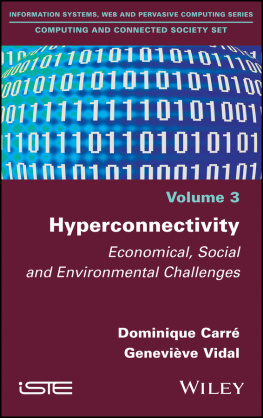Carré Dominique - Hyperconnectivity
Here you can read online Carré Dominique - Hyperconnectivity full text of the book (entire story) in english for free. Download pdf and epub, get meaning, cover and reviews about this ebook. year: 2018, publisher: John Wiley & Sons, Incorporated, genre: Politics. Description of the work, (preface) as well as reviews are available. Best literature library LitArk.com created for fans of good reading and offers a wide selection of genres:
Romance novel
Science fiction
Adventure
Detective
Science
History
Home and family
Prose
Art
Politics
Computer
Non-fiction
Religion
Business
Children
Humor
Choose a favorite category and find really read worthwhile books. Enjoy immersion in the world of imagination, feel the emotions of the characters or learn something new for yourself, make an fascinating discovery.
- Book:Hyperconnectivity
- Author:
- Publisher:John Wiley & Sons, Incorporated
- Genre:
- Year:2018
- Rating:5 / 5
- Favourites:Add to favourites
- Your mark:
- 100
- 1
- 2
- 3
- 4
- 5
Hyperconnectivity: summary, description and annotation
We offer to read an annotation, description, summary or preface (depends on what the author of the book "Hyperconnectivity" wrote himself). If you haven't found the necessary information about the book — write in the comments, we will try to find it.
Hyperconnectivity — read online for free the complete book (whole text) full work
Below is the text of the book, divided by pages. System saving the place of the last page read, allows you to conveniently read the book "Hyperconnectivity" online for free, without having to search again every time where you left off. Put a bookmark, and you can go to the page where you finished reading at any time.
Font size:
Interval:
Bookmark:

Computing and Connected Society Set
coordinated by
Dominique Carr and Genevive Vidal
Volume 3
Dominique Carr
Genevive Vidal

First published 2018 in Great Britain and the United States by ISTE Ltd and John Wiley & Sons, Inc.
Apart from any fair dealing for the purposes of research or private study, or criticism or review, as permitted under the Copyright, Designs and Patents Act 1988, this publication may only be reproduced, stored or transmitted, in any form or by any means, with the prior permission in writing of the publishers, or in the case of reprographic reproduction in accordance with the terms and licenses issued by the CLA. Enquiries concerning reproduction outside these terms should be sent to the publishers at the undermentioned address:
ISTE Ltd
27-37 St Georges Road
London SW19 4EU
UK
www.iste.co.uk
John Wiley & Sons, Inc.
111 River Street
Hoboken, NJ 07030
USA
www.wiley.com
ISTE Ltd 2018
The rights of Dominique Carr and Genevive Vidal to be identified as the authors of this work have been asserted by them in accordance with the Copyright, Designs and Patents Act 1988.
Library of Congress Control Number: 2018951169
British Library Cataloguing-in-Publication Data
A CIP record for this book is available from the British Library
ISBN 978-1-78630-087-4
In the first volume of the series Computing and Connected Society, Andr Vitalis uses a sociohistorical approach to question the uncertain digital revolution, 50 years of computerization, by taking a closer look at the four main social issues which progressively arose from society turning towards IT and from the development of IT applications: social control, security, commercialization, data exchange and communication.
In the second volume of this series, Laurent Gayard studies the rise of the darknet where, unlike the Internet, anonymity is the rule and the identity and location of the user can be concealed, which throws into question the capability of State bodies or market players to set up effective monitoring of the Internet. This desire to escape institutional control responds to ideological and illegal motives and also, most unexpectedly, increasingly economic motives. It promises, sometimes falsely, a globalized system where all borders, boundaries and regulations are obsolete.
The third volume of this series returns to communication and data exchange in order to address the matter of hyperconnectivity brought about by a multi-faceted digital proposal which relies on relational practices as much from companies, governments, groups and communities as from citizens and individuals. Picking up again on the question of data exchange, of interlinking, this volume proposes an analysis of the reasons for this hyperconnectivity from a communication point of view, and to identify its consequences as much on the economy and society as on the environment. The uniqueness of this approach concerns the issues above all viewed through the prism of communicational and relational practices. Focusing on these inevitably leads us to address the opportunities and uses of what is known as Digital Information and Communication Technologies (DICT), signs of a social acceptance of data mining, since the users now emerge as actors and contributors to this hyperconnectivity. Very often the driving force of a socio-economic model based on indirect financing through free access, hyperconnectivity affects the social practices and environmental issues of billions of people worldwide. In fact, in 2018, DICT have become part of our daily lives and are at the core of everything we do, even the most intimate things. Grard Berry says that the world is becoming digital. Digitalization plays such a part in our lives, we could say that online and offline are mixed in our everyday lives (Berry, 2008), so much so that social practices have been technologized and technology has been socialized. As we will see, the main feature of implementing current DICT is to break the users fascination with IT, or even the network players enthrallment to virtualism. The purpose is no longer to take people to a virtual world which cuts them off from others and society, but to immerse them in a social environment where, on the contrary, those who do not approve of the digital injunction are excluded. Online sociability sometimes replaces, but above all complements, extends and enhances more traditional interactions, while redesigning them, as Antonio Casilli points out (Casilli, 2010).
It should be noted although that for some users, this relationship is so intense, so addictive, that without an Internet connection they are like orphans, helpless and deprived. As a report by the World Bank points out, it is worth keeping in mind that while in the so-called developing countries, the diffusion of cell phones the favorite tool to connect to digital services is faster than access to water, only 31% of the population of these countries are connected to the Internet and 60% of the world population remains excluded from the use of digital services.
What makes the exercise difficult is that DICT are ambivalent and paradoxical. They are ambivalent as they can contribute to emancipation and freedom of speech and action, but also to subjection, confined alienation and control. They are paradoxical as they can power a production and exchange system which relies on the communication industry, but its economy relies on practices that are essential for maintaining this system.
Therefore, the analysis of the industrial offer in technical and economic terms, which brings with it diverse remote services and relationships, identifies a socio-economic model that relies on three elements: no cost, financing through advertising and data sales, and constant requests in favor of hyperconnectivity. This generates significant changes in creating links by changing or supplementing social practices with a friendly, cultural or professional vision. However, digital communicative practices have an impact on environmental issues which are too often ignored.
The analysis of a social acceptance of usage data exploitation, which is not a response to an offer, helps us to understand the tension surrounding the users during their experience. In fact, they supply information by negotiating their use while becoming actors of hyperconnectivity, backed by constant innovation. Therefore, the content generated by users and algorithms orchestrates hyperconnectivity, which spreads in all socio-professional groups. This approach challenges the analyses which most often present the strengths and/or the dangers of hyperconnectivity.
The analysis of social acceptability of the computerization of society does not prevent considering the meaning of uses in the framework of a negotiated renunciation. In the context of the uniformization of consent, a contemporary sociality appears alongside environmental risks and injunctions.
Before presenting how this volume is composed, it should be noted that it is based on a number of research projects conducted over several years by the authors on the theme of Innovations in communication: devices, standards and uses at the Laboratories of Information and Communication Sciences (LabSIC) of the University Paris 13 University Sorbonne Paris Cit, as well as their activities with the Association of teachers and researchers CREIS-Terminal (IT and Society Research and Teaching Coordination Center and journal
Next pageFont size:
Interval:
Bookmark:
Similar books «Hyperconnectivity»
Look at similar books to Hyperconnectivity. We have selected literature similar in name and meaning in the hope of providing readers with more options to find new, interesting, not yet read works.
Discussion, reviews of the book Hyperconnectivity and just readers' own opinions. Leave your comments, write what you think about the work, its meaning or the main characters. Specify what exactly you liked and what you didn't like, and why you think so.












